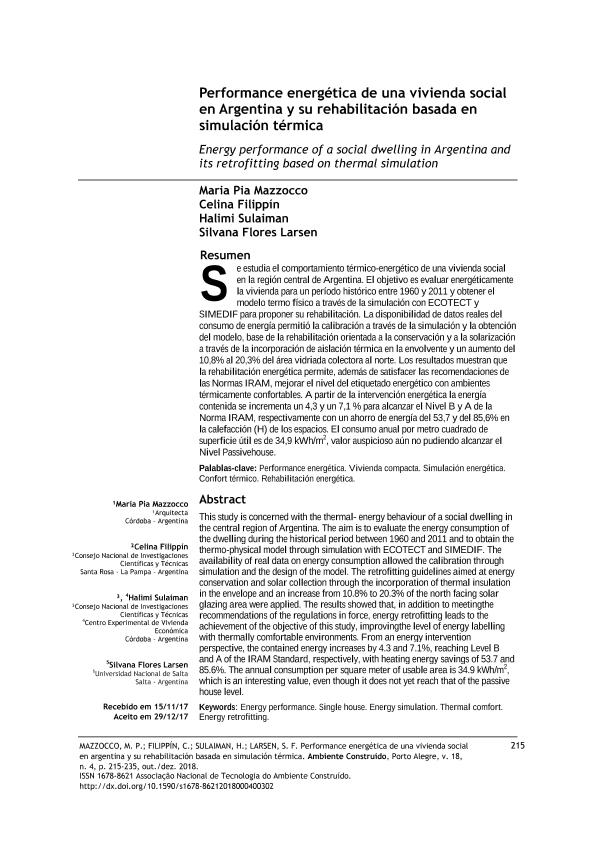Mostrar el registro sencillo del ítem
dc.contributor.author
Mazzocco, Maria Pia

dc.contributor.author
Filippin, Maria Celina

dc.contributor.author
Sulaiman, Halimi Cristina

dc.contributor.author
Flores Larsen, Silvana Elinor

dc.date.available
2019-12-23T16:44:08Z
dc.date.issued
2018-10
dc.identifier.citation
Mazzocco, Maria Pia; Filippin, Maria Celina; Sulaiman, Halimi Cristina; Flores Larsen, Silvana Elinor; Performance energética de una vivienda social en Argentina y su rehabilitación basada en simulación térmica; Associação Nacional de Tecnologia do Ambiente Construído; Ambiente Construido; 18; 4; 10-2018; 215-235
dc.identifier.issn
1415-8876
dc.identifier.uri
http://hdl.handle.net/11336/92746
dc.description.abstract
Se estudia el comportamiento térmico-energético de una vivienda social en la región central de Argentina. El objetivo es evaluar energéticamente la vivienda para un período histórico entre 1960 y 2011 y obtener el modelo termo físico a través de la simulación con ECOTECT y SIMEDIF para proponer su rehabilitación. La disponibilidad de datos reales del consumo de energía permitió la calibración a través de la simulación y la obtención del modelo, base de la rehabilitación orientada a la conservación y a la solarización a través de la incorporación de aislación térmica en la envolvente y un aumento del 10,8% al 20,3% del área vidriada colectora al norte. Los resultados muestran que la rehabilitación energética permite, además de satisfacer las recomendaciones de las Normas IRAM, mejorar el nivel del etiquetado energético con ambientes térmicamente confortables. A partir de la intervención energética la energía contenida se incrementa un 4,3 y un 7,1 % para alcanzar el Nivel B y A de la Norma IRAM, respectivamente con un ahorro de energía del 53,7 y del 85,6% en la calefacción (H) de los espacios. El consumo anual por metro cuadrado de superficie útil es de 34,9 kWh/m2, valor auspicioso aún no pudiendo alcanzar el Nivel Passivehouse.
dc.description.abstract
This study is concerned with the thermal- energy behaviour of a social dwelling in the central region of Argentina. The aim is to evaluate the energy consumption of the dwelling during the historical period between 1960 and 2011 and to obtain the thermo-physical model through simulation with ECOTECT and SIMEDIF. The availability of real data on energy consumption allowed the calibration through simulation and the design of the model. The retrofitting guidelines aimed at energy conservation and solar collection through the incorporation of thermal insulation in the envelope and an increase from 10.8% to 20.3% of the north facing solar glazing area were applied. The results showed that, in addition to meetingthe recommendations of the regulations in force, energy retrofitting leads to the achievement of the objective of this study, improvingthe level of energy labelling with thermally comfortable environments. From an energy intervention perspective, the contained energy increases by 4.3 and 7.1%, reaching Level B and A of the IRAM Standard, respectively, with heating energy savings of 53.7 and 85.6%. The annual consumption per square meter of usable area is 34.9 kWh/m2, which is an interesting value, even though it does not yet reach that of the passive house level.
dc.format
application/pdf
dc.language.iso
spa
dc.publisher
Associação Nacional de Tecnologia do Ambiente Construído
dc.rights
info:eu-repo/semantics/openAccess
dc.rights.uri
https://creativecommons.org/licenses/by-nc-sa/2.5/ar/
dc.subject
PERFORMANCE ENERGÉTICA
dc.subject
VIVIENDA COMPACTA
dc.subject
SIMULACIÓN ENERGÉTICA
dc.subject
CONFORT TÉRMICO
dc.subject
REHABILITACIÓN ENERGÉTICA
dc.subject.classification
Otras Ingenierías y Tecnologías

dc.subject.classification
Otras Ingenierías y Tecnologías

dc.subject.classification
INGENIERÍAS Y TECNOLOGÍAS

dc.title
Performance energética de una vivienda social en Argentina y su rehabilitación basada en simulación térmica
dc.title
Energy performance of a social dwelling in Argentina and its retrofitting based on thermal simulation
dc.type
info:eu-repo/semantics/article
dc.type
info:ar-repo/semantics/artículo
dc.type
info:eu-repo/semantics/publishedVersion
dc.date.updated
2019-10-28T19:50:22Z
dc.identifier.eissn
1678-8621
dc.journal.volume
18
dc.journal.number
4
dc.journal.pagination
215-235
dc.journal.pais
Brasil

dc.description.fil
Fil: Mazzocco, Maria Pia. Consejo Nacional de Investigaciones Científicas y Técnicas. Centro Científico Tecnológico Conicet - Córdoba. Centro Experimental de la Vivienda Económica; Argentina
dc.description.fil
Fil: Filippin, Maria Celina. Instituto Nacional de Tecnología Agropecuaria. Centro Regional Córdoba. Estación Experimental Agropecuaria Manfredi; Argentina
dc.description.fil
Fil: Sulaiman, Halimi Cristina. Consejo Nacional de Investigaciones Científicas y Técnicas. Centro Científico Tecnológico Conicet - Córdoba. Centro Experimental de la Vivienda Económica; Argentina
dc.description.fil
Fil: Flores Larsen, Silvana Elinor. Consejo Nacional de Investigaciones Científicas y Técnicas. Centro Científico Tecnológico Conicet - Salta. Instituto de Investigaciones en Energía no Convencional. Universidad Nacional de Salta. Facultad de Ciencias Exactas. Departamento de Física. Instituto de Investigaciones en Energía no Convencional; Argentina
dc.journal.title
Ambiente Construido

dc.relation.alternativeid
info:eu-repo/semantics/altIdentifier/url/http://ref.scielo.org/xg884y
dc.relation.alternativeid
info:eu-repo/semantics/altIdentifier/doi/http://dx.doi.org/10.1590/s1678-86212018000400302
Archivos asociados
